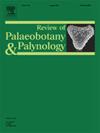Representation of vegetation and climate by modern pollen assemblages on the south-eastern Tibetan Plateau
IF 1.7
3区 地球科学
Q2 PALEONTOLOGY
引用次数: 0
Abstract
Modern pollen distribution and how it relates to vegetation and climate along elevational gradients is crucial information when reconstructing past vegetation and climate from fossil pollen assemblages. In this study, sixty-five samples of moss polsters were collected from an elevation range of 1069–5056 m a.s.l. on the south-eastern Tibetan Plateau (TP) and the relationships between their pollen assemblages and vertical variations in vegetation and climate are investigated. Our results indicate that variations in the pollen assemblages along the elevational gradient reflect the vertical distribution of vegetation. Arboreal pollen grains (predominantly Pinus, Quercus-evergreen, and Betula) can be transported by the wind to high-elevation areas, but percentages of Quercus-evergreen pollen > 10% likely indicate a local source. Thus, interpreting local vegetation from low arboreal pollen percentages can be challenging for stratigraphic pollen assemblages in the south-eastern TP. A redundancy analysis and a boosted regression tree analysis both find that mean temperature of the coldest month (Mtco) explains more of the pollen assemblage variance and the arboreal pollen to non-arboreal pollen (AP/NAP) ratio, accounting for 7.07% and 43.11% respectively. Therefore, Mtco is the most important climatic factor influencing pollen distribution on the south-eastern TP.
青藏高原东南部现代花粉组合对植被和气候的表征
现代花粉分布及其与植被和气候沿海拔梯度的关系是根据化石花粉组合重建过去植被和气候的重要信息。本研究在青藏高原东南部海拔1069 ~ 5056 m范围内采集了65份藓类花粉样品,研究了其花粉组合与植被和气候垂直变化的关系。研究结果表明,花粉组合沿海拔梯度的变化反映了植被的垂直分布。树木花粉粒(主要是松树、常绿栎树和桦树)可以通过风传播到高海拔地区,但常绿栎树花粉的百分比>;10%可能是本地的。因此,从低树木花粉百分比解释当地植被对青藏高原东南部地层花粉组合具有挑战性。通过冗余分析和增强回归树分析发现,最冷月平均温度(Mtco)解释了更多的花粉组合差异和树花粉/非树花粉(AP/NAP)比,分别占7.07%和43.11%。因此,Mtco是影响青藏高原东南部花粉分布最重要的气候因子。
本文章由计算机程序翻译,如有差异,请以英文原文为准。
求助全文
约1分钟内获得全文
求助全文
来源期刊
CiteScore
3.50
自引率
21.10%
发文量
149
审稿时长
6 months
期刊介绍:
The Review of Palaeobotany and Palynology is an international journal for articles in all fields of palaeobotany and palynology dealing with all groups, ranging from marine palynomorphs to higher land plants. Original contributions and comprehensive review papers should appeal to an international audience. Typical topics include but are not restricted to systematics, evolution, palaeobiology, palaeoecology, biostratigraphy, biochronology, palaeoclimatology, paleogeography, taphonomy, palaeoenvironmental reconstructions, vegetation history, and practical applications of palaeobotany and palynology, e.g. in coal and petroleum geology and archaeology. The journal especially encourages the publication of articles in which palaeobotany and palynology are applied for solving fundamental geological and biological problems as well as innovative and interdisciplinary approaches.

 求助内容:
求助内容: 应助结果提醒方式:
应助结果提醒方式:


